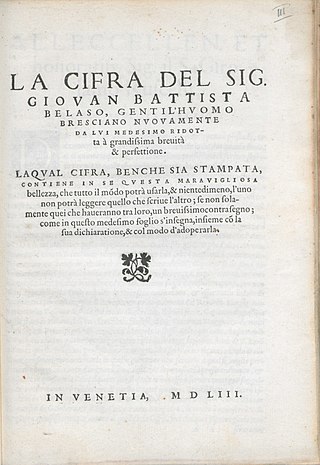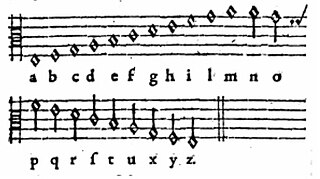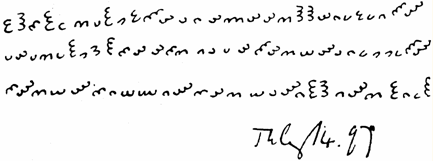
In cryptography, a cipher is an algorithm for performing encryption or decryption—a series of well-defined steps that can be followed as a procedure. An alternative, less common term is encipherment. To encipher or encode is to convert information into cipher or code. In common parlance, "cipher" is synonymous with "code", as they are both a set of steps that encrypt a message; however, the concepts are distinct in cryptography, especially classical cryptography.
In cryptography, a substitution cipher is a method of encrypting in which units of plaintext are replaced with the ciphertext, in a defined manner, with the help of a key; the "units" may be single letters, pairs of letters, triplets of letters, mixtures of the above, and so forth. The receiver deciphers the text by performing the inverse substitution process to extract the original message.

In cryptography, a transposition cipher is a method of encryption which scrambles the positions of characters (transposition) without changing the characters themselves. Transposition ciphers reorder units of plaintext according to a regular system to produce a ciphertext which is a permutation of the plaintext. They differ from substitution ciphers, which do not change the position of units of plaintext but instead change the units themselves. Despite the difference between transposition and substitution operations, they are often combined, as in historical ciphers like the ADFGVX cipher or complex high-quality encryption methods like the modern Advanced Encryption Standard (AES).

In the history of cryptography, the "System 97 Typewriter for European Characters" or "Type B Cipher Machine", codenamed Purple by the United States, was an encryption machine used by the Japanese Foreign Office from February 1939 to the end of World War II. The machine was an electromechanical device that used stepping-switches to encrypt the most sensitive diplomatic traffic. All messages were written in the 26-letter English alphabet, which was commonly used for telegraphy. Any Japanese text had to be transliterated or coded. The 26-letters were separated using a plug board into two groups, of six and twenty letters respectively. The letters in the sixes group were scrambled using a 6 × 25 substitution table, while letters in the twenties group were more thoroughly scrambled using three successive 20 × 25 substitution tables.

A cryptogram is a type of puzzle that consists of a short piece of encrypted text. Generally the cipher used to encrypt the text is simple enough that the cryptogram can be solved by hand. Substitution ciphers where each letter is replaced by a different letter or number are frequently used. To solve the puzzle, one must recover the original lettering. Though once used in more serious applications, they are now mainly printed for entertainment in newspapers and magazines.

Edward Elgar composed his Variations on an Original Theme, Op. 36, popularly known as the Enigma Variations, between October 1898 and February 1899. It is an orchestral work comprising fourteen variations on an original theme.

In cryptanalysis, frequency analysis is the study of the frequency of letters or groups of letters in a ciphertext. The method is used as an aid to breaking classical ciphers.

The Playfair cipher or Playfair square or Wheatstone–Playfair cipher is a manual symmetric encryption technique and was the first literal digram substitution cipher. The scheme was invented in 1854 by Charles Wheatstone, but bears the name of Lord Playfair for promoting its use.

The Beale ciphers are a set of three ciphertexts, one of which allegedly states the location of a buried treasure of gold, silver and jewels estimated to be worth over 43 Million US dollars as of January 2018. Comprising three ciphertexts, the first (unsolved) text describes the location, the second (solved) ciphertext accounts the content of the treasure, and the third (unsolved) lists the names of the treasure's owners and their next of kin.

The pigpen cipher is a geometric simple substitution cipher, which exchanges letters for symbols which are fragments of a grid. The example key shows one way the letters can be assigned to the grid.
The Two-square cipher, also called double Playfair, is a manual symmetric encryption technique. It was developed to ease the cumbersome nature of the large encryption/decryption matrix used in the four-square cipher while still being slightly stronger than the single-square Playfair cipher.

The Alberti Cipher, created in 1467 by Italian architect Leon Battista Alberti, was one of the first polyalphabetic ciphers. In the opening pages of his treatise De componendis cifris he explained how his conversation with the papal secretary Leonardo Dati about a recently developed movable type printing press led to the development of his cipher wheel.

Giovan Battista Bellaso was an Italian cryptologist.
The cipher system that the Uesugi are said to have used is a simple substitution usually known as a Polybius square or "checkerboard." The i-ro-ha alphabet contains forty-eight letters, so a seven-by-seven square is used, with one of the cells left blank. The rows and columns are labeled with a number or a letter. In the table below, the numbers start in the top left, as does the i-ro-ha alphabet. In practice these could start in any corner.
A musical cryptogram is a cryptogrammatic sequence of musical symbols which can be taken to refer to an extra-musical text by some 'logical' relationship, usually between note names and letters. The most common and best known examples result from composers using musically translated versions of their own or their friends' names as themes or motifs in their compositions. These are not really rigorous cipher algorithms in the formal sense, but more like musical monograms. The methods used historically by composers were either too incomplete or too simplistic to meaningfully encrypt long text messages. There is a separate history of music ciphers utilizing music notation to encode messages for reasons of espionage or personal security that involved encryption and/or steganography.
ʻAfīf al-Dīn ʻAlī ibn ʻAdlān al-Mawsilī, born in Mosul, was an Arab cryptologist, linguist and poet who is known for his early contributions to cryptanalysis, to which he dedicated at least two books. He was also involved in literature and poetry, and taught on the Arabic language at the Al-Salihiyya Mosque of Cairo.
Enigma Variations (My Friends Pictured Within) is a one-act ballet by Frederick Ashton, to the music of the Variations on an Original Theme (Enigma Variations), Op. 36, by Edward Elgar. The work was first given by the Royal Ballet at the Royal Opera House, Covent Garden, London, on 25 October 1968. It has been revived in every subsequent decade.
Unsolved! The History and Mystery of the World’s Greatest Ciphers from Ancient Egypt to Online Secret Societies is a 2017 book by American mathematician and cryptologist Craig P. Bauer. The book explores the history and challenges of various unsolved ciphers, ranging from ancient scripts to modern codes and puzzles. The book also invites readers to try their hand at cracking the ciphers, offering clues and hints along the way. The book received positive reviews from critics and readers, who praised its engaging style, comprehensive coverage, and intriguing content.

In cryptography, a music cipher is an algorithm for the encryption of a plaintext into musical symbols or sounds. Music-based ciphers are related to, but not the same as musical cryptograms. The latter were systems used by composers to create musical themes or motifs to represent names based on similarities between letters of the alphabet and musical note names, such as the BACH motif. Whereas music ciphers were systems typically used by cryptographers to hide or encode messages for reasons of secrecy or espionage.












